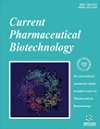- Home
- A-Z Publications
- Current Pharmaceutical Biotechnology
- Previous Issues
- Volume 24, Issue 1, 2023
Current Pharmaceutical Biotechnology - Volume 24, Issue 1, 2023
Volume 24, Issue 1, 2023
-
-
Green Synthesis: A Land of Complex Nanostructures
More LessThe green synthesis of nanomaterials is nowadays gaining great attention owing to several beneficial aspects in terms of the low toxicity of reagents and by-products, low damage to the health and the environment, sustainability of energy savings and rational use of natural resources. The intrinsic complexity offered by the biological sources (plants, microorganisms, animal products) and the conditions applied in the sy Read More
-
-
-
Antipyretic Medicinal Plants, Phytocompounds, and Green Nanoparticles: An Updated Review
More LessAuthors: Priya Chaudhary, Rohit Sharma, Sonam Rawat and Pracheta JanmedaPyrexia itself is not a terminal condition. Basically, it occurs with mild to serious diseases affecting alarge population of the world. Other than a high body temperature, pyrexia is accompanied by several sickness behaviors, changes in physiological and metabolic characteristics of the body system, and alterations in the immune responses. Various allopathic drugs are available to treat pyrexia by targeting the symptom or th Read More
-
-
-
Nucleic Acid Nanotechnology: Trends, Opportunities and Challenges
More LessNucleic acids (DNA and RNA) hold great potential for the advancement of future medicine but suffer from unsatisfactory clinical success due to the challenges accompanied with their delivery. Nucleic acid-mediated nanomaterials have riveted the researchers from the past two decades and exhilarating tasks have prevailed. Nucleic acid nanotechnology offers unique control over the shape, size, time, mechanics and anisotro Read More
-
-
-
Green Synthesized Nanomaterials for Safe Technology in Sustainable Agriculture
More LessNanotechnology is a new emerging cutting-edge technology in the 21st century and has applications in medical, cosmetics, electronics, energy, food, agriculture, and many sectors. Nanomaterials (NMs) are the main component of nanotechnology. NMs prepared by chemical routes are very hazardous and not safe for life. Therefore, attempts are being made to prepare NMs via different green routes. It is expected that nanot Read More
-
-
-
Recent Advances in Biomedical Applications of Biogenic Nanomaterials
More LessThe synthesis of biogenic nanoparticles from readily available natural resources may have large demand in numerous fields including pharmaceuticals and medicine. The biogenic nanoparticles catch the attention of the scientific community due to their low cytotoxicity and biocompatibility. Chemical, physical, and greener methods are used for the synthesis of biogenic nanoparticles. Researchers used eco-fri Read More
-
-
-
Water Purification by Green Synthesized Nanomaterials
More LessAuthors: Anindita De, N.B. Singh, Mridula Guin and Sumit BarthwalBackground: Water pollution is one of the important causes of human fatality in the world, particularly in underdeveloped or developing countries. Moreover, with rapid industrialization and urbanization, the problem of water pollution is posing a severe threat to health and livelihood. The pollutants found in water are of varied nature and depend on the source of the water. Several techniques have so far been adopted to p Read More
-
-
-
Green Nanomaterials for Photocatalytic Degradation of Toxic Organic Compounds
More LessAuthors: Saika Ahmed, Gulshan Ara and Md. Abu Bin Hasan SusanIn recent years, nanomaterials as photocatalysts have gained much popularity for the removal of organic pollutants from tainted water using photodegradation, since the available chemical, physical, and biological methods are often time consuming, involve high cost and dumping complications, sometimes posing serious threat to both human health and environmental elements. The use of nanomaterials is less ex Read More
-
-
-
Green Polymer Nanocomposites in Automotive and Packaging Industries
More LessAuthors: Mohammad Harun-Ur-Rashid, Abu Bin Imran and Md. Abu Bin Hasan SusanGreen polymer nanocomposites referred to as completely biodegradable, renewable, environmentally friendly, and benign materials, have received a surge of attention to promote sustainable development. Polymer nanocomposites, where nanomaterials are used for reinforcement, possess a large interfacial area per volume, and the intervals between the filler nanoparticles and polymer matrix are significantly short. Read More
-
-
-
Novel Approaches for the Application of Herbs for Skin Care
More LessSkin is the largest non–parenchymal organ of the human body. It constitutes a natural barrier against pathogens and harmful environmental exposures and contributes to the human body's homeostasis. Conditions affecting the skin range from infections and injury to autoimmune diseases and cancer. Herbs have been used to treat dermatological conditions for a long time. Traditional approaches to delivering herbs to the s Read More
-
-
-
Recent Advances in the Applications of Green Synthesized Nanoparticle based Nanofluids for the Environmental Remediation
More LessAuthors: Shriram S. Sonawane, Parag P. Thakur, Manjakuppam Malika and Hafiz M. AliWith the ever-growing importance of green technology, the utilization of inorganic metal oxide nanoparticles and their nanofluids against microorganisms garnered more attention than organic metal oxides in recent years. Therefore, using safer, energy and cost-effective natural raw materials, stabilizing agents, and solvents are the fundamental considerations of the greener process. Due to their unique properties, lar Read More
-
Volumes & issues
-
Volume 26 (2025)
-
Volume 25 (2024)
-
Volume 24 (2023)
-
Volume 23 (2022)
-
Volume 22 (2021)
-
Volume 21 (2020)
-
Volume 20 (2019)
-
Volume 19 (2018)
-
Volume 18 (2017)
-
Volume 17 (2016)
-
Volume 16 (2015)
-
Volume 15 (2014)
-
Volume 14 (2013)
-
Volume 13 (2012)
-
Volume 12 (2011)
-
Volume 11 (2010)
-
Volume 10 (2009)
-
Volume 9 (2008)
-
Volume 8 (2007)
-
Volume 7 (2006)
-
Volume 6 (2005)
-
Volume 5 (2004)
-
Volume 4 (2003)
-
Volume 3 (2002)
-
Volume 2 (2001)
-
Volume 1 (2000)
Most Read This Month
Article
content/journals/cpb
Journal
10
5
false
en


